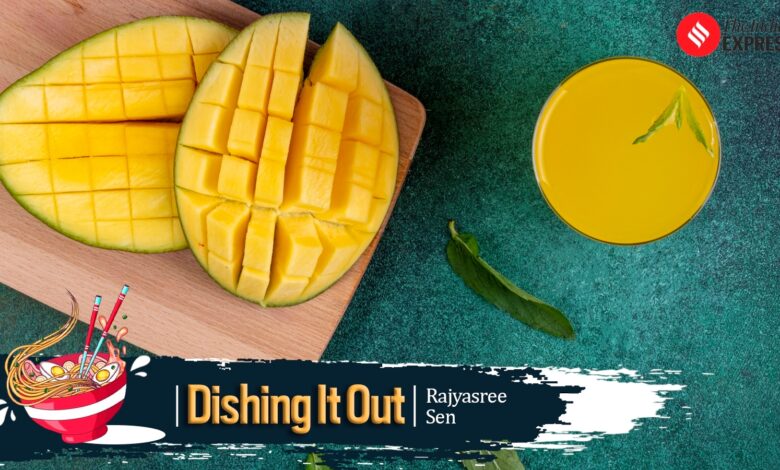Beyond Alphonso: Why no mango compares to Indian varieties | Food-wine News

This is the best season of the year: mango season. It is that time of the year when markets in India will be enveloped the sweet scent of ripe mangoes, and you are bombarded with emails announcing various mango festivals.I try locally grown mangoes in every country and always come away disappointed. Whether it’s the Thai mango, the Sri Lankan variety, or the monstrously large yellow Pakani mangoes that flood Delhi’s markets once India’s mango season ends, none compares. They simply lack the depth of flavour and aroma of Indian mangoes. I’m not being jingoic when I say so.
For a fruit so ubiquitous across India, almost synonymous with the country itself — given how many crates of Alphonso mangoes are carted abroad people visiting family––it isn’t indigenous to India. Yes, we did have some local varieties, but it was the Portuguese, who travelled to and later ruled Goa and parts of western India, who introduced grafting techniques that improved them. We can thank them for the smooth, non-fibrous texture of Alphonso mango pulp and its rich orangey-yellow colour.
Story continues below this ad
Alphonso mangoes are named after Afonso de Albuquerque, a Portuguese general and viceroy who played a key role in establishing Portuguese colonies in India during the 16th century. He also cultivated mango varieties that were more suited to the European palate—firm, sweet, and easy to cut and slice rather than being squeezed and sucked.
But credit doesn’t go to the Portuguese alone. Before they arrived, the Mughals were great appreciators of mangoes and were instrumental in their spread across India. Akbar is said to have planted an orchard with 100,000 mango trees. Babur was reportedly lured into defeating Ibrahim Lodi with the promise of a crate of mangoes. His son Humayun, who spent much of his life in exile, allegedly demanded that mangoes be delivered to him wherever he was. In fact, the Humayun pasand, also known as Imam pasand, is said to be named after him, while the Chausa mango was named Sher Shah Suri after he defeated Humayun’s army in the Bihari village of the same name.
While I do love Alphonso mangoes, my childhood favourites were the tiny yellow mangoes that fit perfectly in my palm as a kid—prosaically called Chuski aam. You’d squeeze them, make a small gash at the top, and suck out the deliciously sweet flesh. In India, mangoes aren’t just eaten as fruit. They’re used in desserts like aam kheer (also known as payasam) and shrikhand, as well as smoothies and lassis. I’ve also had delicious mango kulfi, our homemade version of creamy ice lollies.
In India, mangoes aren’t just eaten as fruit. They’re used in desserts like aam kheer (also known as payasam) and shrikhand, as well as smoothies and lassis. (Photo: Freepik)
To me, the king of mangoes isn’t the Alphonso—it’s the Langra. Greener and rounder than many other varieties, it’s smaller and far sweeter than the Alphonso. Originally from near Varanasi, the Langra mango is said to be named after the “lame” farmer who first cultivated it. Langra means lame in Hindi and Bengali.Story continues below this ad
The delightful Kesar mango is a highly underappreciated variety. Originating from Gujarat and Saurashtra, its name—meaning saffron—comes from its colour and fragrance. If you are making desserts, milkshakes and other goodies, this is a good mango to use because the pulp is non-fibrous.
The Dussehri mango, harvested from a village of the same name in Uttar Pradesh, is slightly longer than most other mangoes. It remains green on the outside, never turning yellow, and it tastes divine.
The Totapuri mango, with its green, elliptical shape, is great for salads and salsas but not so much for eating on its own, as it isn’t very sweet. Speaking of sweet, I once tried Badami mangoes while visiting a friend in Bangalore. If you want a sugar rush like no other, this is the one for you.
Make the most of mango season and try as many varieties as possible. Here’s one of my favourite recipes using mangoes: Mango Salsa. It’s the perfect accompaniment to a main course or a great starter with nachos.
Mango Salsa
Ingredients:Story continues below this ad
1 large mango, chopped into small pieces1 green capsicum, diced1 red capsicum, diced1 small onion, diced½ cup chopped coriander3 chillies, finely choppedJuice of 1 limeSalt to taste
Method:
– Mix all the ingredients.– Be careful not to mash the mango pieces––they should retain their shape.– Refrigerate for at least 30 minutes before serving.
Next week, I’ll write about one of my favourite street foods—phuchka, also known as paani puri or golgappa. Each region has its own version, and I’ll tell you which one I think is the best.







